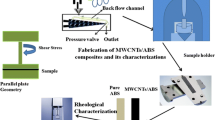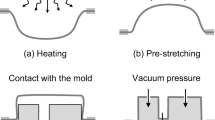Abstract
The viscous flow transition of triblock copolymer styrene-isoprene-styrene (SIS5562) was studied by rheological methods. A broad loss factor (tan \(\delta\)) peak at 152.5 ℃ appeared on the dynamic viscoelastic spectrum under experimental conditions. Some similar peaks had been attributed to order-order transition (OOT) or order-disorder transition (ODT) in some research. In this system, the SAXS, time-temperature superposition (TTS) and Han plots proved that the microstructure of the SIS5562 did not undergo OOT or ODT transition in the temperature range. It may be the viscous flow transition as we supposed previously. The rheology study by capillary and rotation rheometer verified that the viscous flow transition temperature (Tf) was around 150 ℃.








Similar content being viewed by others
Reference
Bates FS, Fredrickson GH (1999) Block copolymers—designer soft materials. Phys Today 52:32–38
Bates FS, Hillmyer MA, Lodge TP, Bates CM, Delaney KT, Fredrickson GH (2012) Multiblock polymers: panacea or pandora’s box? Science 336:434–440
Yang HW, Canich JAM, Licciardi GF (1996) Thermoplastic elastomers. US
Bonart R (1979) Thermoplastic elastomers. Polymer 20:1389–1403
Holden G, Bishop ET, Legge NR (2010) Thermoplastic elastomers. Journal of Polymer Ence Part C Polymer Symposia 26:37–57
Bates FS, Fredrickson GH (1990) Block copolymer thermodynamics: theory and experiment. Annu Rev Phys Chem 41:525–557
Lee H-K, Zin W-C (2000) Phase diagrams for the blends of a styrene-butadiene diblock copolymer and a styrene-butadiene random copolymer: Theory. Macromolecules 33:2894–2900
Zhu Y, Gido S, Iatrou H, Nikos H, Mays J (2003) Microphase separation of cyclic block copolymers of styrene and butadiene and of their corresponding linear triblock copolymers. Macromolecules 36:148–152
Yamaguchi D, Hashimoto T, Han CD, Baek DM, Kim JK, Shi A-C (1997) Order−disorder transition, microdomain structure, and phase behavior in binary mixtures of low molecular weight polystyrene-block-polyisoprene copolymers. Macromolecules 30:5832–5842
Wanakule NS, Panday A, Mullin SA, Gann E, Hexemer A, Balsara NP (2009) Ionic conductivity of block copolymer electrolytes in the vicinity of order−disorder and order−order transitions. Macromolecules 42:5642–5651
Bates F, Rosedale J, Fredrickson G (1990) Fluctuation effects in a symmetric diblock copolymer near the order-disorder transition. J Chem Phys 92:6255–6270
Ogawa T, Sakamoto N, Hashimoto T, Han CD, Baek DM (1996) Effect of volume fraction on the order− disorder transition in low molecular weight polystyrene-block-polyisoprene copolymers. 2. Order− disorder transition temperature determined by small-angle X-ray scattering. Macromolecules 29:2113–2123
Hashimoto T, Ijichi Y, Fetters L (1988) Order–disorder transition of starblock copolymers. J Chem Phys 89:2463–2472
Qin J, de Pablo JJ (2016) Ordering transition in salt-doped diblock copolymers. Macromolecules 49:3630–3638
Winter HH, Scott DB, Gronski W, Okamoto S, Hashimoto T (1993) Ordering by flow near the disorder-order transition of a triblock copolymer styrene-isoprene-styrene. Macromolecules 26:7236–7244
Krishnamoorti R, Modi MA, Tse MF, Wang HC (2000) Pathway and kinetics of cylinder-to-sphere order−order transition in block copolymers. Macromolecules 33:3810–3817
Hahn H, Chakraborty AK, Das J, Pople JA, Balsara NP (2005) Order−disorder transitions in cross-linked block copolymer solids. Macromolecules 38:1277–1285
Maher MJ, Jones SD, Zografos A, Xu J, Schibur HJ, Bates FS (2018) The order-disorder transition in graft block copolymers. Macromolecules 51:232–241
Lee S-H, Char K, Kim G (2000) Order−disorder and order−order transitions in mixtures of highly asymmetric triblock copolymer and low molecular weight homopolymers. Macromolecules 33:7072–7083
Leibler L (1980) Theory of microphase separation in block copolymers. Macromolecules 13:1602–1617
Tanaka Y, Hasegawa H, Hashimoto T, Ribbe A, Sugiyama K, Hirao A, Nakahama S (1999) A study of three-phase structures in ABC triblock copolymers. Polym J 31:989–994
Mathew I, George KE, Francis DJ (1994) Viscous and elastic behaviour of SEBS triblock copolymer. Die Angewandte Makromolekulare Chemie 217:51–59
Lee P-C, Wang C-C, Chen C-Y (2020) Synthesis of high-vinyl isoprene and styrene triblock copolymers via anionic polymerization with difunctional t-BuLi initiator. Eur Polym J 124:109476
Sakamoto N, Hashimoto T, Han CD, Kim D, Vaidya NY (1997) Effect of addition of a neutral solvent on the order−order and order−disorder transitions in a polystyrene-block-polyisoprene-block-polystyrene copolymer. Macromolecules 30:5321–5330
Han CD, Baek DM, Kim JK (1990) Effect of microdomain structure on the order-disorder transition temperature of polystyrene-block-polyisoprene-block-polystyrene copolymers. Macromolecules 23:561–570
Sakamoto N, Hashimoto T, Han CD, Kim D, Vaidya NY (1997) Order−order and order−disorder transitions in a polystyrene-block-polyisoprene-block-polystyrene copolymer. Macromolecules 30:1621–1632
Ferri D, Canetti M (2006) Spurt and melt flow distorsions of linear styrene-isoprene-styrene triblock copolymers. J Rheol 50:611–624
Han H, Tian G, Gao Q, Hu H, Zhao J, Li J (2020) Wall slip of styrene-isoprene-styrene (SIS) triblock copolymer induced by micro elastic phase. Polymer 209:122990
Leibler Ludwik (1980) Theory of microphase separation in block copolymers. J Dalian Inst Tech 13:1602–1617
Williams ML, Landel RF, Ferry JD (1955) The temperature dependence of relaxation mechanisms in amorphous polymers and other glass-forming liquids. J Am Chem Soc 77:3701–3707
Wang M-J, Lu SX, Mahmud K (2000) Carbon–silica dual-phase filler, a new-generation reinforcing agent for rubber. Part VI. Time–temperature superposition of dynamic properties of carbon–silica-dual-phase-filler-filled vulcanizates. J Polym Sci B Polym Phys 38:1240–1249
Mahdavi R, Goodarzi V, Ali Khonakdar H, Hassan Jafari S, Reza Saeb M, Shojaei S (2018) Experimental analysis and prediction of viscoelastic creep properties of PP/EVA/LDH nanocomposites using master curves based on time–temperature superposition. J Appl Polym Sci 135:46725
Collins DA, Yakacki CM, Lightbody D, Patel RR, Frick CP (2016) Shape-memory behavior of high-strength amorphous thermoplastic poly(para-phenylene). J Appl Polym Sci 133:42903
Vaidyanathan TK, Vaidyanathan J, Cherian Z (2003) Extended creep behavior of dental composites using time–temperature superposition principle. Dent Mater 19:46–53
Zhang T, Zhao Y, Zhang B (2018) A method based on the time–temperature superposition principle to predict pressurization time in compression molding. J Appl Polym Sci 135:46664
Nakano T (2013) Applicability condition of time–temperature superposition principle (TTSP) to a multi-phase system. Mech Time-Depend Mater 17:439–447
Jamarani R, Erythropel HC, Burkat D, Nicell JA, Leask RL, Maric M (2017) Rheology of green plasticizer/poly(vinyl chloride) blends via time-temperature superposition. Processes 5:43
Vananroye A, Leen P, Van Puyvelde P, Clasen C (2011) TTS in LAOS: validation of time-temperature superposition under large amplitude oscillatory shear. Rheologica Acta 50:795–807
Dealy J, Plazek D (2009) Time-temperature superposition-a users guide. Rheol Bull 78:16–31
Naya S, Meneses A, Tarrío-Saavedra J, Artiaga R, López-Beceiro J, Gracia-Fernández C (2013) New method for estimating shift factors in time–temperature superposition models. J Therm Anal Calorim 113:453–460
Bae J-E, Cho KS, Seo KH, Kang D-G (2011) Application of geometric algorithm of time-temperature superposition to linear viscoelasticity of rubber compounds. Korea-Australia Rheology Journal 23:81–87
Chronakis IS, Doublier J-L, Piculell L (2000) Viscoelastic properties for kappa- and iota-carrageenan in aqueous NaI from the liquid-like to the solid-like behaviour. Int J Biol Macromol 28:1–14
Oroian M, Amariei S, Escriche I, Gutt G (2013) A viscoelastic model for honeys using the time-temperature superposition principle (TTSP). Food Bioprocess Technol 6:2251–2260
Tsuji T, Mochizuki K, Okada K, Hayashi Y, Obata Y, Takayama K, Onuki Y (2019) Time–temperature superposition principle for the kinetic analysis of destabilization of pharmaceutical emulsions. Int J Pharm 563:406–412
Kossuth MB, Morse DC, Bates FS (1999) Viscoelastic behavior of cubic phases in block copolymer melts. J Rheol 43:167–196
Hadjichristidis N, Pispas S, Floudas G (2003) Viscoelastic properties of block copolymers. John Wiley & Sons, Ltd
Foerster S, Khandpur AK, Zhao J, Bates FS, Hamley IW, Ryan AJ, Bras W (1994) Complex phase behavior of polyisoprene-polystyrene diblock copolymers near the order-disorder transition. Macromolecules 27:6922–6935
Khandpur AK, Foerster S, Bates FS, Hamley IW, Ryan AJ, Bras W, Almdal K, Mortensen K (1995) Polyisoprene-polystyrene diblock copolymer phase diagram near the order-disorder transition. Macromolecules 28:8796–8806
Han CD, Baek DM, Kim JK, Ogawa T, Sakamoto N, Hashimoto T (1995) Effect of volume fraction on the order-disorder transition in low molecular weight polystyrene-block-polyisoprene copolymers. 1. order-disorder transition temperature determined by rheological measurements. Macromolecules 28:5043–5062
Han CD, Kim J, Kim JK (1989) Determination of the order-disorder transition temperature of block copolymers. Macromolecules 22:383–394
Han CD, Kim J (1987) Rheological technique for determining the order–disorder transition of block copolymers. J Polym Sci B Polym Phys 25:1741–1764
Han CD, Kim JK (1989) Molecular theory for the viscoelasticity of compatible polymer mixtures. 2. Tube model with reptation and constraint release contributions. Macromolecules 22:4292–4302
Dae Han C, Kim JK (1993) On the use of time-temperature superposition in multicomponent/multiphase polymer systems. Polymer 34:2533–2539
Huggins ML (1961) Viscoelastic Properties of Polymers. J Am Chem Soc 83:4110–4111
Hoffman EJ (1972) Viscoelastic Transition. J Eng Ind 94:732–737
Faerber GL, Kim SW, Eyring H (1970) Viscous flow and glass transition temperature of some hydrocarbons. J Phys Chem 74:3510–3518
Li Y, Liu X, Zhuang X, Jin X, Liu Q (2016) Rheological behavior and spinnability of ethylamine hydroxyethyl chitosan/cellulose co-solution in N-methylmorpholine-N-oxide system. Fibers and Polymers 17:778–788
Drabek J, Zatloukal M, Martyn M (2018) Effect of molecular weight on secondary Newtonian plateau at high shear rates for linear isotactic melt blown polypropylenes. J Non-Newtonian Fluid Mech 251:107–118
Yanovsky Y (1993) Polymer Rheology: Theory and Practice
Zheng Q, Du M, Yang B, Wu G (2001) Relationship between dynamic rheological behavior and phase separation of poly(methyl methacrylate)/poly(styrene-co-acrylonitrile) blends. Polymer 42:5743–5747
Zheng Q, Zhang XW, Pan Y, Yi XS (2002) Polystyrene/Sn–Pb alloy blends. I. Dynamic rheological behavior. J Appl Polym Sci 86:3166–3172
Acknowledgement
This work was supported by the Natural Science Foundation of Shandong Province (ZR201807060363, Nos.2017GGX20132).
Funding
The Opening Project of State Key Laboratory of Polymer Materials Engineering (Sichuan University) (Grant No. sklpme2020-4-04).
Author information
Authors and Affiliations
Corresponding authors
Additional information
Publisher's Note
Springer Nature remains neutral with regard to jurisdictional claims in published maps and institutional affiliations.
Rights and permissions
About this article
Cite this article
Luo, H., Han, H., Chi, H. et al. Research on the viscous flow transition of styrene-isoprene-styrene triblock copolymer by Rheology. J Polym Res 28, 160 (2021). https://doi.org/10.1007/s10965-021-02521-1
Received:
Accepted:
Published:
DOI: https://doi.org/10.1007/s10965-021-02521-1




